Christmas at Longwood Gardens
Longwood Gardens in Kennett Square, PA was originally the estate of Pierre S. du Pont, "industrialist, conservationist, farmer, designer, impresario, and philanthropist" (I'm quoting from a brochure). The Gardens bills itself as "the world's premier horticultural display garden, offering magnificent horticultural displays throughout the year plus spectacular fountains, performing arts, and educational events". So when Rutgers Gardens offered a field trip for their volunteers to see the Christmas displays and lights, I jumped at the chance to go. I wasn't disappointed.
I brought my camera, of course, and took 223 pictures. I would have taken more (my memory card holds 532), but I ran out of batteries! I had only brought two sets. No, I'm not going to make you look at all 223 photos in one sitting. I'm going to divide the trip up into multiple posts. It will be easier to absorb and give me something to blog about during this non-gardening time.
Our first stop was the du Pont home. On our way there, we saw a tree decorated for wildlife.
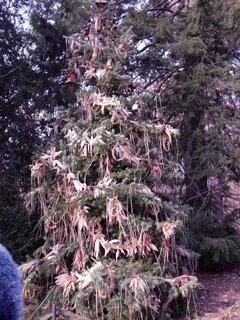
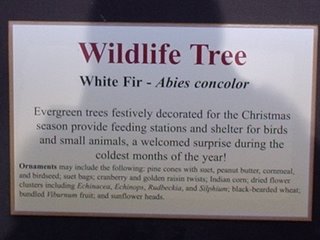 The really amazing thing about this tree was that it was filled with birds! They were everywhere. In it, under it, on top of it. I was astounded to see a junco, normally a groundfeeder, eagerly attacking one of the "deorations" near the top of the tree.
The really amazing thing about this tree was that it was filled with birds! They were everywhere. In it, under it, on top of it. I was astounded to see a junco, normally a groundfeeder, eagerly attacking one of the "deorations" near the top of the tree.
Immediately in front of the house were reindeer topiary:
They even had Rudolph!
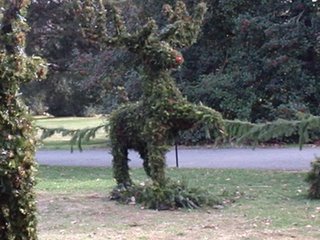
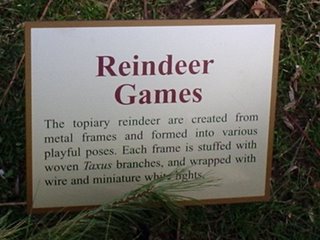 The house itself is absolutely fascinating. It was built over two centuries. For more details, you can go here . You enter through the Conservatory which was added to the house in 1914. I loved this Christmas tree because it was decorated like my own with just glass ornaments. Admittedly, my tree and ornaments aren't nearly as nice as these!
The house itself is absolutely fascinating. It was built over two centuries. For more details, you can go here . You enter through the Conservatory which was added to the house in 1914. I loved this Christmas tree because it was decorated like my own with just glass ornaments. Admittedly, my tree and ornaments aren't nearly as nice as these! Behind it you can see one of the incredible hanging baskets composed entirely of poinsettias:
Behind it you can see one of the incredible hanging baskets composed entirely of poinsettias:
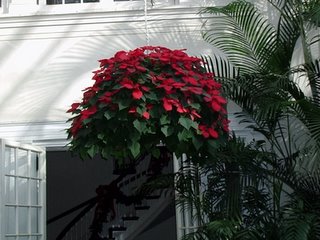 This was the first of many fountains I saw at Longwood.
This was the first of many fountains I saw at Longwood.
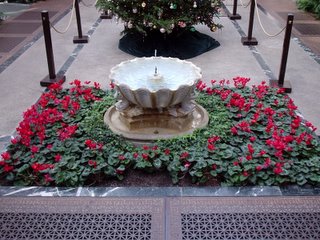 Be prepared for lots of pictures of fountains, waterfalls and streams. As I'm sure you recall from my fall foliage stroll at Rutgers Gardens, I have a fascination with water in the landscape. There were lots of other interesting plants in the conservatory. I have no idea what this is.
Be prepared for lots of pictures of fountains, waterfalls and streams. As I'm sure you recall from my fall foliage stroll at Rutgers Gardens, I have a fascination with water in the landscape. There were lots of other interesting plants in the conservatory. I have no idea what this is.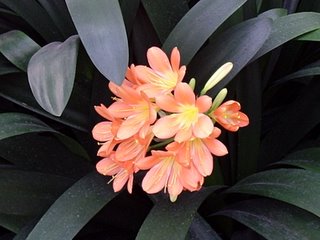 I was amazed to see a Bird of Paradise. Little did I know that there are tons of them in the main conservatory on the grounds.
I was amazed to see a Bird of Paradise. Little did I know that there are tons of them in the main conservatory on the grounds.
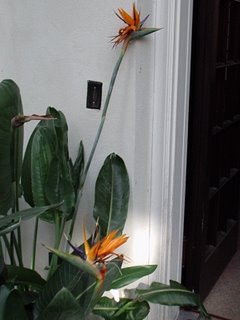 If I had a fern this big, I'd have to move out of my house. There wouldn't be room enough for both of us.
If I had a fern this big, I'd have to move out of my house. There wouldn't be room enough for both of us. This area, immediately behind the conservatory, is called the Foyer.
This area, immediately behind the conservatory, is called the Foyer.
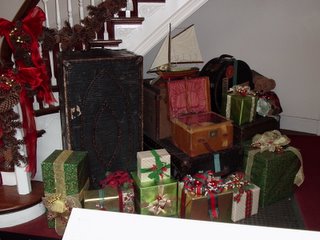 What I really liked about it was the garland on the bannister.
What I really liked about it was the garland on the bannister.
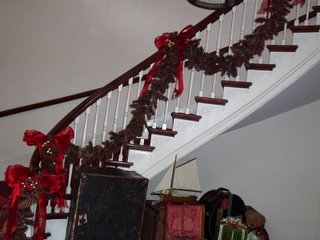 It's made entirely of pinecones rather than the usual greenery. The oldest parts of the house had tiny rooms and steep stairways just like you would expect in a house built in the 18th century. It also had some neat features like this huge fireplace in the dining room built in 1764.
It's made entirely of pinecones rather than the usual greenery. The oldest parts of the house had tiny rooms and steep stairways just like you would expect in a house built in the 18th century. It also had some neat features like this huge fireplace in the dining room built in 1764.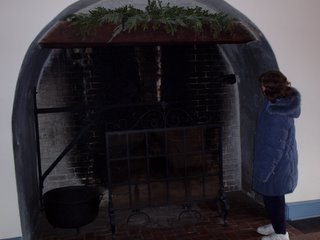 The woman in the picture is a volunteer at Rutgers Gardens. She "volunteered" to pose for me to provide scale. Also in the dining room are displays illustrating the construction of various features of the house and estate including the Main Fountain Garden. This is one of the fountains.
The woman in the picture is a volunteer at Rutgers Gardens. She "volunteered" to pose for me to provide scale. Also in the dining room are displays illustrating the construction of various features of the house and estate including the Main Fountain Garden. This is one of the fountains.
 I just loved this frog in the Flower Room built in 1824.
I just loved this frog in the Flower Room built in 1824.
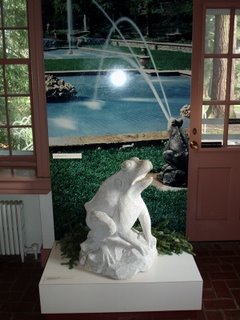
The main Conservatory on the grounds is enormous. I don't know if my photos can even begin to convey its size. This is what I saw when I first walked in. And this is just the entrance!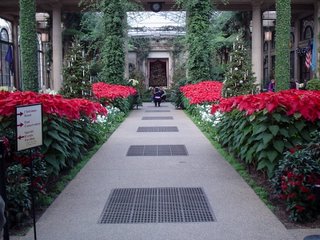 Those poinsettias are approximately 3' (1 m) tall. They had some interesting plant combinations. I'm not sure how I feel about pink amaryllis and Dusty Miller.
Those poinsettias are approximately 3' (1 m) tall. They had some interesting plant combinations. I'm not sure how I feel about pink amaryllis and Dusty Miller.
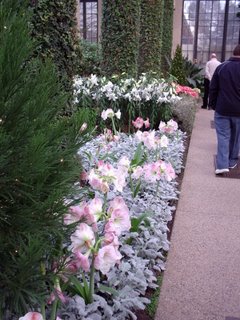 In combination with pink poinsettias, they don't look too bad.
In combination with pink poinsettias, they don't look too bad.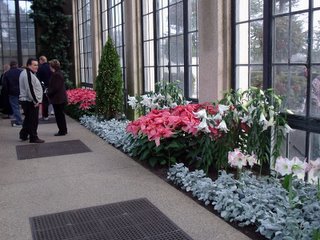 I find tulips in January deeply disturbing.
I find tulips in January deeply disturbing.
 Ditto snapdragons. By the way, are snapdragons supposed to get this tall?
Ditto snapdragons. By the way, are snapdragons supposed to get this tall?
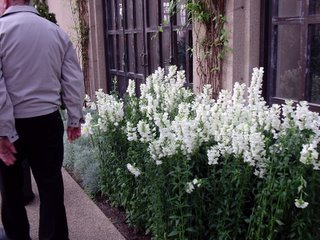 There were some marvelous displays. This one is composed entirely of Christmas Cactus (cacti?).
There were some marvelous displays. This one is composed entirely of Christmas Cactus (cacti?).  This one was made up of . . . sorry, I've forgotten. Looks like begonias, maybe?
This one was made up of . . . sorry, I've forgotten. Looks like begonias, maybe?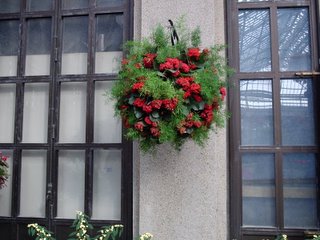 More Birds of Paradise.
More Birds of Paradise.
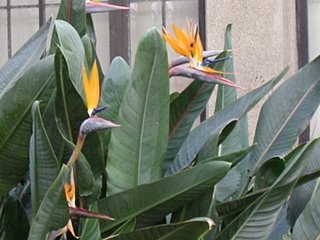 And, of course, poinsettias.
And, of course, poinsettias.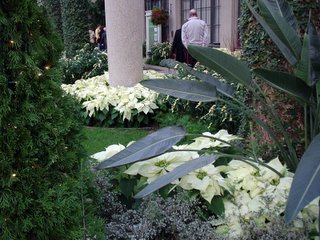 Lots and lots of poinsettias.
Lots and lots of poinsettias. The east wing of the conservatory has just been renovated. I wonder where they kept these bamboo during the renovations?
The east wing of the conservatory has just been renovated. I wonder where they kept these bamboo during the renovations?
 I loved the ferns planted underneath. I wonder if my ferns will ever look this nice?
I loved the ferns planted underneath. I wonder if my ferns will ever look this nice?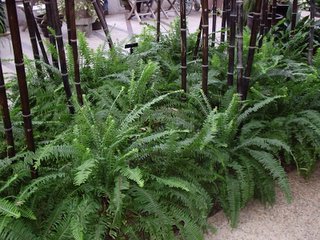 I'm sure this is also some kind of fern, but there was no tag to identify it.
I'm sure this is also some kind of fern, but there was no tag to identify it.
 This plant was labelled. Leopard Plant. Makes sense. The leaves are spotted like a Leopard.
This plant was labelled. Leopard Plant. Makes sense. The leaves are spotted like a Leopard. Except that on the other side of the room is this plant, also labelled Leopard Plant.
Except that on the other side of the room is this plant, also labelled Leopard Plant.
 There were themed Christmas trees throughout the conservatory. I tried to take pictures of them with their signs, but that didn't work out well at all. This one I think this is the one with the garland of dried hydrangeas.
There were themed Christmas trees throughout the conservatory. I tried to take pictures of them with their signs, but that didn't work out well at all. This one I think this is the one with the garland of dried hydrangeas.
 I know that this is the one with the garland made up of living plants, but I can't remember what they were. It never occurred to me to bring anything to make notes on and I saw so much that I couldn't possibly remember all the details.
I know that this is the one with the garland made up of living plants, but I can't remember what they were. It never occurred to me to bring anything to make notes on and I saw so much that I couldn't possibly remember all the details.
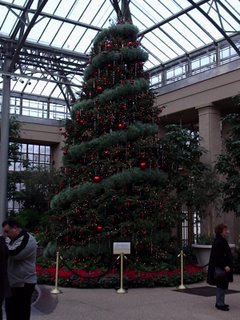
I can't for the life of me remember any details about these two trees.
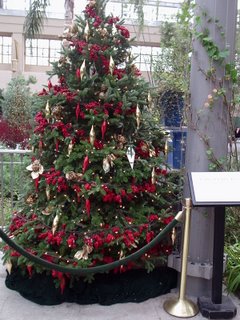
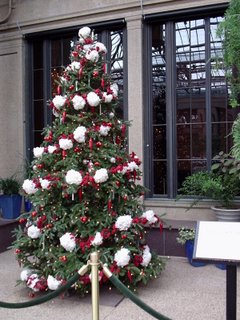 The final picture in this post is a tribute to the generosity of one of my fellow Master Gardener classmates. I have a brown thumb when it comes to houseplants. She gave me a plant she swears even I can't kill.
The final picture in this post is a tribute to the generosity of one of my fellow Master Gardener classmates. I have a brown thumb when it comes to houseplants. She gave me a plant she swears even I can't kill.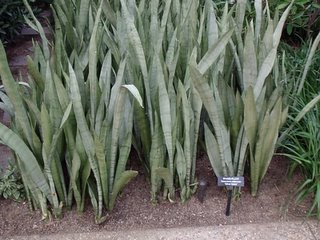 So here it is. The Longwood Gardens Snake Plant. Thank you for having faith in me. Hopefully my Snake Plant will also look like this someday.
So here it is. The Longwood Gardens Snake Plant. Thank you for having faith in me. Hopefully my Snake Plant will also look like this someday.I will post more pictures tomorrow. Bring your swim fins and goggles. There will be lots and lots of water pictures!







7 Comments:
I'm pretty sure that peachy colored flower near the beginning of your photo tour is clivia. In these parts it is normally grown as a houseplant. And I have read in seed catalogs that some snapdragons can grow to 3 ft. They are often billed as especially good for cutting for flower arrangements. I have never grown them so tall myself, though. Snapdragons are perennial in warmer climates and when I'm lucky they will even winter over for me.
The Snake Plant is what we call Mother-In-Law Tongues. And I have a small one from the plant my mom got as a wedding gift...some 36 years ago. I don't think they can be killed at all. Good luck with yours!
Oldroses who cares if you can't remember all the info the photos are just awesome and I can hardly wait to see more.
Those snake plants are very hard to destroy, also they do bloom for some people (not me) and the flowers are fragile looking and fragrant.
I second the diagnosis of the peach flower as clivia. There is an article on clivia in the latest issue of Martha Stewart Living. I want one!
That was an awesome tour. I can't wait for more!
I love to visit old houses and gardens!
That is so cool, i wish i could go! Thanks for posting the pictures, i am really enjoying them! Yes, that is a clivia, i have one that my mom gave me last summer and it has not bloomed yet. They have nice foliage though, even when not in bloom.
I love the Wildlife Tree....I want to try that idea! A really great time you had!
Post a Comment
<< Home